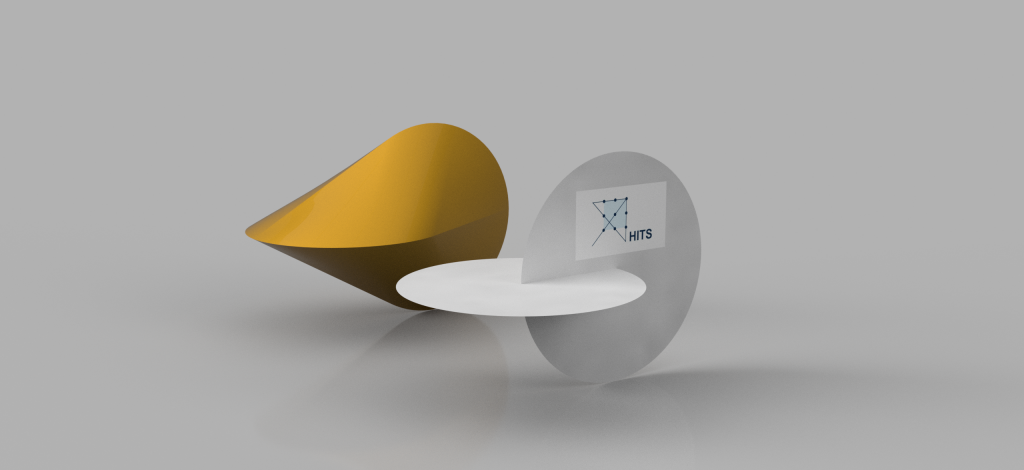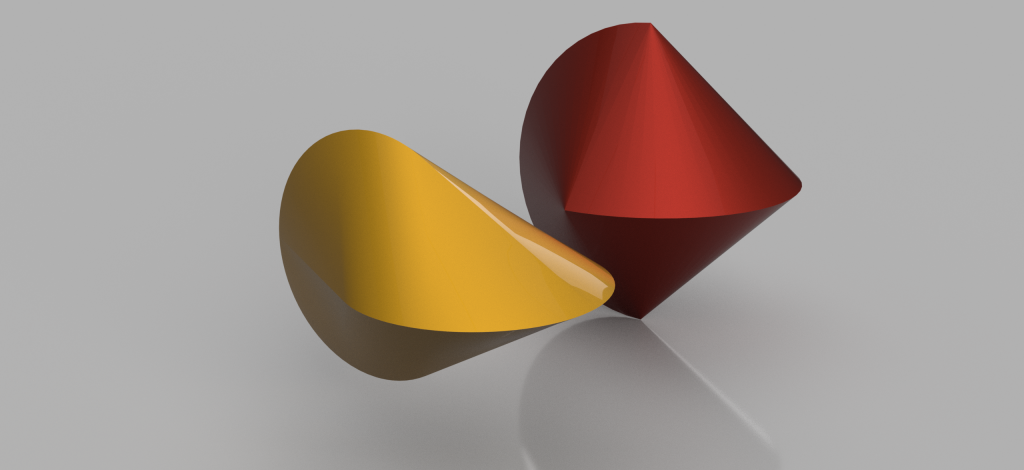The Oloid
The oloid is a solid which has been discovered by Paul Schatz in the beginning of the 20th century. He was studying how to turn a cube inside out. On the way, he discovered the oloid, since the trajectories of certain points of the cube form an oloid.
In many different respects, the oloid is interesting. It is aesthetic, it has interesting mathematical features, and it can even be used as a propeller for smoothly and efficiently mixing chemicals.
Construction of the oloid

On the right: two beer coasters put together. The convex hull of these beer coasters is an oloid (on the left). 
Difference between an oloid (yellow) and a sphericon (red). The oloid does not possess corners, and hence may be aesthetically more pleasing. More information about the sphericon can be found in the articles Polysphericons and Polycons.
We can construct the oloid as the convex hull of two circles standing perpendicular to each other. The centers of these disks have distance r, where r is the radius of each disk. This configuration is also called the “regular oloid”. In this article, we will stick to the convention that “oloid” stands for a regular oloid.
Irregular oloids roll differently. In particular, choosing r·√2 ≈ 1.4r for the distance between the centers results in much smoother rolling, since its center of mass is at constant height (see below).
Rolling motion
The oloid’s most interesting property is its rolling behaviour. It rolls very different from solids such as a sphere or a Steinmetz solid. After all, it does not roll smoothly or in a straight line:
However, we can explain the meandering motion the concept of the center of mass:
The center of mass is an abstract point. We can think of it as possessing the whole object’s mass. It is sufficient to know the height of the center of mass to calculate the potential energy of the whole solid.
The maximal and minimal height of the center of mass are h1 = 1/2·√2·r resp. h2 = 3/8·√3·r . The difference in height is only around Δh ≈ 0.05·r. Its rolling motion therefore seems very smooth.
We can write the physical law of conservation of energy as Ekin + Epot = Etot, where the letter E stands for kinetic (motion of the center of mass and rotation), potential and total energy, respectively.
Since the total energy is constant, the distribution of total energy into kinetic and potential energy determines the rolling speed. When the center of mass is at the highest position, the potential energy is the greatest, and thence the rolling is the slowest and vice versa.
Further information (links outside HITS):
- Invertible cube: http://www.paul-schatz.ch/en/discoveries/the-invertible-cube/
- Interactive simulation of the rolling motion: https://demonstrations.wolfram.com/MovementOfAnOloid/
- Oloids as mixing devices (commercial): http://oloid.ch/index.php/en/
- The oloid’s parametric equation: https://www.mathcurve.com/surfaces.gb/orthobicycle/orthobicycle.shtml
- Computation of highest and lowest height of center of mass: https://pdfs.semanticscholar.org/5120/a8268079a301626f631c7852608b8e3dd980.pdf